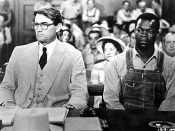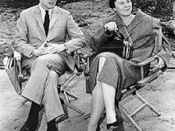Harper Lee's To Kill A Mockingbird is concerned with a loss of innocence. Discuss by referring to two key scenes in the novel.
Harper Lee's To Kill A Mockingbird is certainly about a loss of innocence. However, this aspect is only emphasised to convey a more powerful and meaningful message. It is a mean by which the author introduces and effectively represents the main issue of concern in the novel; prejudice and discrimination. The use of Scout, Jem and Dill's "loss of innocence" is used throughout the novel, including during the court case and the children's visit to the jail. Through this the author aims to highlight the matter of prejudices and evoke empathy and understanding in the readers.
One of Scout's first encounters with prejudice, and subsequent "loss of innocence", is during the children's interruption at the jail house where Tom Robinson was being held. On impulse, the children arrived at the jail to encounter several men confronting Atticus.
At this time, Scout was quite unaware of what was happening, being totally oblivious to the threat the men posed to the safety of herself, Atticus, Jem and Dill. She was merely expecting an argument between the men and was eager to witness it. Her naivete becomes even more evident in her "talk" with Mr Cunningham. She began conversation to be polite, possibly to impress the adults present. As she was not encumbered by the knowledge of the impending danger, she talked freely with Mr Cunningham, the only man she knew in the group present.
Unknowingly, Scout prompted Mr Cunningham to see his faults and underlying prejudices. She talks about Mr Cunningham's son, Walter, and tells of having him over for dinner. The Cunninghams' poverty and social status were unimportant to Scout or any of the Finches. Walter was a...


